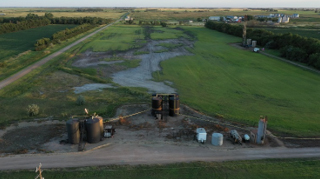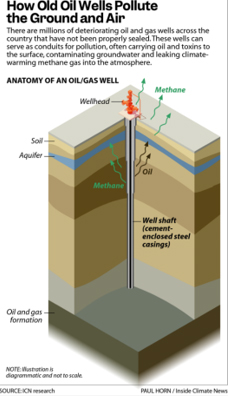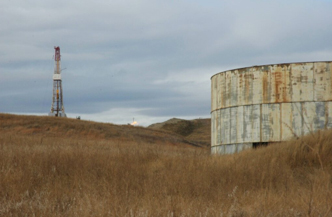|
Oil Wells Orphaned in North
Dakota Require Federal and State Help. May 23, 2021
Fossil Fuels
North Dakota, Using Taxpayer Funds, Bailed Out Oil and Gas Companies
by Plugging Abandoned Wells
The bailout, environmentalists say, raises bigger questions about who
will pay, in an energy transition, to close off the nation’s millions
of aging wells.

By Nicholas
Kusnetz
May 23, 2021

An abandoned oil well sits on a
farm in Western North Dakota, with contamination spreading into the
field beyond it. Credit: Daryl Peterson
Related
When North Dakota directed more than $66 million in federal pandemic
relief funds to clean up old oil and gas wells last year, it seemed
like the type of program everyone could get behind. The money would
plug hundreds of abandoned wells and restore the often-polluted land
surrounding them, and in the process would employ oilfield workers who
had been furloughed after prices crashed.
The program largely accomplished those goals. But some environmental
advocates say it achieved another they didn’t expect: It bailed out
dozens of small to mid-sized oil companies, relieving them of their
responsibility to pay for cleaning up their own wells by using
taxpayer money instead.
Oil drillers are generally required to plug their wells after they’re
done producing crude. But in practice, companies are often able to
defer that responsibility for years or decades. Larger companies often
sell older wells to smaller ones, which sometimes go bankrupt, leaving
the wells with no owner.
These “orphaned wells” become the responsibility of the federal or
state governments, depending on where they were drilled. While oil
companies are required to post bonds or other financial assurance to
pay for plugging them, in reality those bonds cover only a tiny
fraction of the costs, leaving taxpayers on the hook. One estimate, by
the Carbon Tracker Initiative, a financial think tank, found that
those bonds cover only a tiny fraction of the expected costs of
cleaning up the nation’s oil and gas wells.
“What happened was a bunch of people got a free ride,” said Scott
Skokos, executive director of the Dakota Resource Council, a
grassroots environmental group in the state.
Skokos said it only deepened his sense that the state had bailed out
the industry. In October, regulators were granted permission from
state lawmakers to send about $16 million of the CARES Act funds as
grants to oil companies to help them buy water to hydraulically
fracture new wells, a step the regulators said was necessary to expend
the funds by the end of the year. Nine companies took advantage of the
program. In one case, a single company, Continental Resources,
received $5.4 million, according to state records.
Wyoming also sent about $30 million in Covid relief funds to oil
companies as grants to either frack new wells or revive or plug old
ones.
Some advocates say that such well-plugging programs highlight a larger
problem: Millions of aging, unplugged oil and gas wells dot the ground
from Appalachia to California, often carrying oil and toxins to the
surface, contaminating groundwater and leaking climate-warming methane
gas into the atmosphere.
The Environmental Protection Agency estimates that the nation’s
unplugged wells leaked about 263,000 tons of methane in 2019, which,
when compared to carbon dioxide over a 20-year period, is equivalent
to the climate-warming emissions of more than 5 coal-fired power
plants. The agency added that the actual figure could be significantly
smaller or three times greater.
While many of the wells—hundreds of thousands at least—are orphaned,
many more are still operated by oil companies that critics say have
avoided plugging them because of regulations that allow the industry
to postpone cleaning them indefinitely, eventually dumping the
responsibility on taxpayers.
President Joe Biden’s American Jobs Plan calls for spending $16
billion to clean up the nation’s orphaned wells and coal and hardrock
mines, and lawmakers have drafted bills with similar goals.

Environmentalists, leaders in both political parties and
the oil industry all support directing federal dollars to plug
orphaned wells as a way to address climate change and pollution, while
creating jobs for oilfield workers. But some advocates say that what
happened in North Dakota shows the risks of spending billions of
dollars without sufficient scrutiny and without requiring oil
companies to put up more money to pay for plugging their wells.
“There’s an incredible opportunity to begin cleaning up and better
cataloging orphan wells while creating well-paying jobs,” said Sara
Cawley, a legislative representative for Earthjustice, an
environmental nonprofit. But, she said, any federal spending needs to
be tied with regulatory reforms, including requiring companies to set
aside more money for plugging, “so that taxpayers are not continuing
to pay for clean-up in perpetuity.”
Two bills have been introduced so far. Both would direct billions of
dollars to plug orphaned wells on state, federal and tribal lands, and
both include language that would encourage states to improve
well-plugging regulations by tying a portion of the funding to
reforms. Only one, however, by Rep. Teresa Leger Fernandez (D-N.M.),
would require oil companies to purchase more expensive bonds when
drilling on federal land, leaving more money available in case of
default.
Lynn Helms, director of North Dakota’s Department of Mineral
Resources, defended the state’s program from criticism that it bailed
out the industry, saying it targeted companies that were facing
financial stress because of last year’s crash in oil prices, and that
in some cases, small, mom-and-pop operations did not have the funds to
plug the wells. He said his department has begun to pursue
reimbursement from some of the companies that are still solvent, and
has already obtained more than $3 million to reimburse a state
well-plugging fund that covered some costs beyond the $66 million from
the CARES Act.
He said the program served the intent of the CARES Act—to stimulate
the economy and support employment—by creating more than 3,700 jobs,
“and that was the number one purpose for why we did this.”
Helms said the $16 million in grants for fracking was also intended to
support workers and state finances, which are highly dependent on tax
revenues from oil production. The grants, he said, supported about 600
jobs and boosted production in December, shoring up funding for
schools and other programs. While he acknowledged that Continental and
other companies were essentially given a multi-million dollar
discount, “that wasn’t the purpose,” he said.
Some environmental advocates have countered that, whatever the intent,
North Dakota effectively gave the oil industry a backdoor subsidy and
sent an implicit signal that taxpayers will come to its rescue when
times are tough.
“In North Dakota I think the story is in some ways a fairly succinct
one,” said Nikki Reisch, director of the climate and energy program at
the Center for International Environmental Law, which highlighted the
state’s program in a recent report. “Taxpayer dollars were being used
to pick up polluters’ tabs, while at the same the state was
repurposing federal funds to support new fracking, making the very
same problem worse.”
’Pollution Vectors’
No one knows how many old wells are scattered across the nation’s oil
and gas fields. According to the Interstate Oil and Gas Compact
Commission, states have identified nearly 57,000 orphaned wells, but
estimate there are hundreds of thousands more undocumented ones. The
EPA has estimated there are more than 3 million abandoned wells,
regardless of whether they have owners or not. Often, companies can
avoid plugging wells when they are no longer productive by calling
them idled, a status that can last decades.
Locally, old wells can contaminate groundwater and foul farmland,
spewing not only petroleum but also toxic, highly salty water.
Abandoned well sites render sections of farmers’ fields unusable.
Companies are generally required to purchase bonds when they drill
wells as a form of insurance—governments can confiscate the bonds if
companies fail to plug their own wells. Lawmakers or regulators
determine the levels for those bonds—for example, $10,000 per well or
$150,000 for all a company’s wells within a state—but in many cases
those levels were set decades ago, and barely begin to cover plugging
costs.
Carbon Tracker has collected data on more than 2.4 million catalogued,
unplugged wells, including all the nation’s active wells, and has
estimated it would cost about $288 billion to plug them. But its
analysis showed that state and federal bonds would cover only about 1
percent of that cost, raising the question of who will pay the
difference if companies go bankrupt or fail to plug their wells. That
estimate for the coverage of bonds excluded Texas, for which Carbon
Tracker was unable to obtain data. Last week, New Mexico’s State Land
Office released a report that found that oil company bonds in the
state covered 2 percent of the expected cleanup costs, falling $8.1
billion short.
Rob Schuwerk, executive director of Carbon Tracker’s North American
office, said the looming transition away from oil and gas will make
the problem worse. It is one thing if industry revenues are stable or
growing, and companies only occasionally bail on their cleanup
responsibilities. But if oil and gas demand begins to decline, the
industry is likely to face falling revenues and a spike in
bankruptcies, just as companies abandon a wave of unprofitable wells.
They might not have money to plug their own wells, leaving taxpayers
on the hook.

An abandoned oil tank from an old oil boom
sits on a ranch in western North Dakota, as a rig drills a new well in
the distance and a flare burns beyond it. Credit: Nicholas Kusnetz
Last year served as a preview, when global lockdowns sent oil demand
plummeting. In North Dakota, that meant oil companies had to shut
their wells and layoff workers as their revenues dwindled.
The conditions prompted warnings of bankruptcies, and led regulators
to ask the state to spend CARES Act relief funds on plugging and
remediating abandoned wells, which they warned could become orphaned
if not addressed.
In order to plug the wells, the state had to assume ownership of them,
a step that was welcomed by Ron Ness, who runs the North Dakota
Petroleum Council, which represents the industry. But at a state
hearing last year, Ness warned regulators against also seizing the
bonds companies had bought as insurance for plugging the wells.
Although the bonds might help pay plugging costs, seizing them would
have “very real” impacts that would prove to be “extremely
problematic,” Ness said.
Ness argued that the CARES Act was effectively reimbursing the state
for the cost of plugging the wells. If regulators did seize the bonds,
he argued, the state could have to return funds to the federal
government.
The petroleum council did not respond to phone messages or emails. But
Schuwerk said that confiscating a bond could pose problems for the
company that purchased it. Bond companies could suddenly view that
company as a risk, and require it to pay higher premiums for its other
bonds, for example, driving up drilling costs.
Regulators have largely granted Ness’s request, at least so far.
According to data provided by the Department of Mineral Resources, the
state confiscated 320 wells and had plugged 280 as of May, at a cost
of $39.3 million, including $6.1 million that came from a state
well-plugging fund financed with industry fees and penalties and taxes
on production. The state “reclaimed”—or cleaned up—only 173 of the
sites.
But so far, the state has confiscated bonds worth only about $3.4
million, while it is pursuing another $1.5 million through civil
action, Helms said. All of that money would go to reimburse the state
fund, rather than the CARES Act money. Helms said that while they are
still looking into it, the rules of the CARES Act may dictate that the
state cannot or should not reimburse the federal government.
The department said that seven companies, responsible for 77 of the
confiscated wells, have either entered bankruptcy or were determined
to be insolvent. The rest of the wells, however, were owned by
companies that continue to pump oil in the state.
Cobra Oil and Gas, for example, had 121 wells confiscated. State
records say the Texas-based company has another 369 active wells,
suggesting there may have been revenue to cover plugging costs. Cobra
did not respond to phone messages or emails.
Keep Environmental Journalism Alive
ICN provides award-winning, localized climate coverage free of charge
and advertising. We rely on donations from readers like you to keep
going to ICN’s donation partner.
Helms said companies like Cobra “are not off the hook,” adding, “I
don’t think I can tell you that we’re going to pursue full
reimbursement, but I think I can commit we’re going to pursue at least
some reimbursement from those companies.”
Helms said the North Dakota Legislature has made changes in bonding
and regulations in recent years that are intended to prevent the
14,000 wells that have been drilled in North Dakota over the past
decade from facing a similar fate. Wells that have been idled for 18
months, for example, are now required to have dedicated bonds, rather
than being covered by a “blanket bond” for all of a company’s wells in
the state.
Wyoming also sent CARES Act funds as grants to oil companies, which
they could use to frack wells they had already drilled or to plug
older wells. According to data provided by the Wyoming Business
Council, which administered the funds, Devon Energy received nearly
$5.8 million, which it used both to frack new wells and plug old ones.
Six other companies, including Occidental Petroleum, received more
than $1 million each.
Randall Luthi, chief energy advisor to Wyoming Gov. Mark Gordon, said
in a statement to Inside Climate News that the spending was
“completely appropriate,” adding that thousands of people in the state
were unable to find work last year. He said the program provided “an
economic and environmental shot in the arm for Wyoming at a time when
it was needed,” and that, “CARES money was always intended for
solvent, but struggling companies.”
Neither Devon, Occidental nor Continental Resources responded to
requests for comment.
Skokos, of the Dakota Resource Council, said he supported cleaning up
old wells, but that the way it was administered was “basically a
bailout for the industry.”
“We could have been using that money for other things like paid family
leave or money for actual workers increasing unemployment,” he said.
“There’s people that were struggling.”
Adam Peltz, a senior attorney with the Environmental Defense Fund,
said it was unlikely that any federal efforts to plug orphaned wells
would be spent on wells with solvent owners, as it was in North Dakota
and Wyoming.
“The overwhelming, vast majority of this money will be spent on
pre-regulatory wells that really have not a trace of an owner on
record,” he said. Pennsylvania, Ohio and other eastern states where
some of the first oil wells were drilled, for example, have hundreds
of thousands of orphaned wells and little funding to plug them. “And
they’re just going to sit there as pollution vectors,” Peltz said,
“until and unless we come up with a lot of money to plug them. The
good news is we’re in a moment where money is flowing for good
causes.”
He noted that some states, including North Dakota, have also begun to
improve their bonding requirements.
But Reisch, of the Center for International Environmental Law, warned
that those changes have hardly begun closing the gap.
“The looming legacy of the oil and gas industry, and of the fossil
fuel economy, is really going to be this ghost infrastructure and
these toxic wells,” she said. “The magnitude of the problem and the
funds needed to address it properly is really daunting.”

Nicholas Kusnetz
Reporter, New York City
Nicholas Kusnetz is a reporter for
InsideClimate News. Before joining ICN, he worked at the Center for
Public Integrity and ProPublica. His work has won numerous awards,
including from the American Association for the Advancement of Science
and the Society of American Business Editors and Writers, and has
appeared in more than a dozen publications, including The Washington
Post, Businessweek, The Nation, Fast Company and The New York Times.
You can reach Nicholas at
nicholas.kusnetz@insideclimatenews.org
and securely at
nicholas.kusnetz@protonmail.com.
Green Play Ammonia™, Yielder® NFuel Energy.
Spokane, Washington. 99212
www.exactrix.com
509 995 1879 cell, Pacific.
exactrix@exactrix.com
|